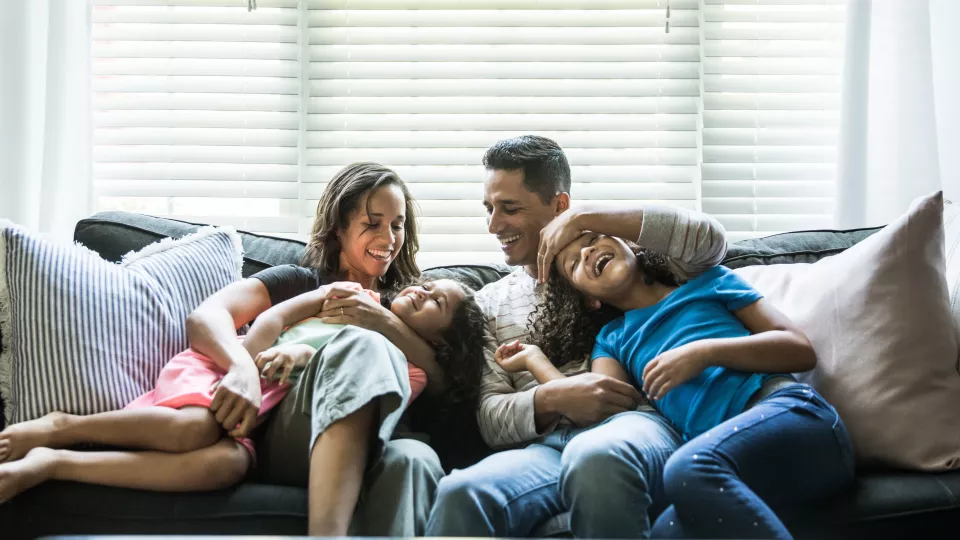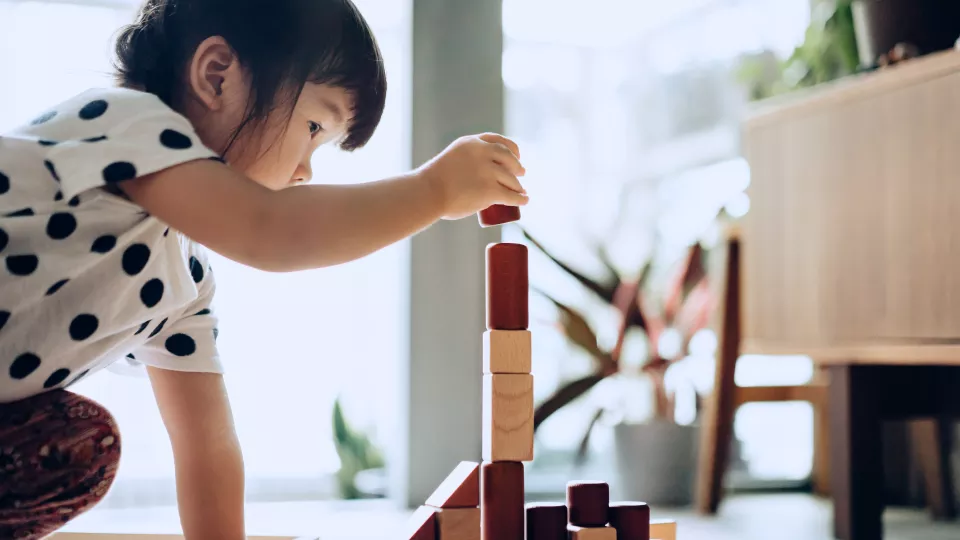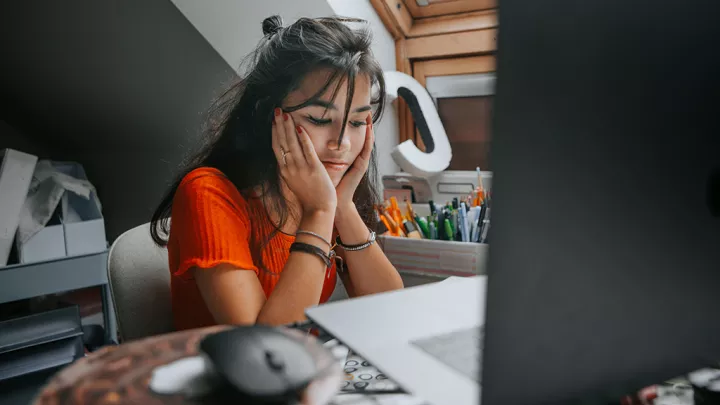
Screen Time Guidelines for Kids, at Every Age: CHLA Experts Weigh In
Summary:
- Screen time guidelines differ based on your child’s developmental age.
- Excessive screen time at any age can affect behavior and development in both the short and the long term.
- Interactive “screen-free” activities help kids develop critical language, emotional regulation, socialization and creative problem-solving skills.
- Screen-time boundaries are most effective when the whole family collaborates on a plan.
Picture your morning routine: How many minutes (or seconds) do you make it into the day before picking up your smartphone or opening your laptop?
In an increasingly digital world, most of us need screens for nearly every aspect of our lives, from work to home and everywhere in between. Data from Nielsen estimates that the average American spends over 11 hours per day interacting with media.
Now, think of kids: Many have never known a reality without screens. Even babies seem to be born with a built-in knowledge of how to navigate a smartphone. But research shows us just how important it is to monitor how much time kids spend consuming media to ensure their brains and bodies have proper time and space to develop.
While avoiding screens altogether is nearly impossible in 2024, establishing healthy boundaries and routines around media use will ensure your child can thrive as they grow.
Read the Children’s Hospital Los Angeles guide on screen time for all ages, which includes official recommendations from the American Academy of Pediatrics for young children, and the expert perspectives of three CHLA leaders who specialize in behavioral-developmental health:
- Anya Griffin, PhD, Director of Psychology
- Douglas Vanderbilt, MD, MS, MBA, Chief, Division of Developmental-Behavioral Pediatrics
- Marian Williams, PhD, Program Area Lead for the Early Childhood Mental Health Program
How do experts define ‘screen time’?

The American Academy of Pediatrics (AAP) defines screen time as any time spent watching screens, including smartphones, tablets, gaming consoles, TVs and computers. When the COVID-19 pandemic shifted realities for many families, the AAP added one important exception to this rule: interactive video chatting with family and friends.
“Technology has advanced our lives in so many wonderful ways,” says Anya Griffin, PhD. “Establishing healthy screen habits is about creating balance while respecting that technology is always going to be part of our lives.”
Screen-time recommendations
For infants (0-2 years old)
Strictly limit all digital media use. This includes “background” activities like having the TV on or using your phone when your child is in the same room, which can disrupt the type of focused play that is most helpful for babies’ developing brains.
Video calls with family and friends are appropriate.
For toddlers (2-5 years old)
Up to one hour per day of high-quality programming designed for the very young is appropriate.
To enrich your toddler’s screen-time experience, try co-viewing shows with them, answering questions and encouraging conversations about the program’s content.
For elementary school-age kids (5-12 years old)
Experts recommend establishing clear boundaries around screen time that prioritize adequate sleep (9-12 hours) and physical activity (more than one hour).
For teens (13 years old and above)
For teens, the negative effects of excessive screen time on their mental and emotional well-being are well-documented.
Work with your teen to establish clear boundaries and a family plan that defines how long they should be using screens, where they can use screens and which types of content they can consume. Prioritize adequate sleep (8-10 hours) and physical activity (more than one hour).
Experts also emphasize the importance of monitoring your teen's social media exposure and keeping an eye on their online activities to protect them from potential risks.

The power of unstructured play (at every age)
Young children
“We know that young children learn with their entire bodies,” says Dr. Griffin. “That’s the amazing thing about young brains.” She emphasizes that practicing gross motor activities (engaging the arms, legs and torso) is just as important for infants and toddlers as developing fine motor skills (using the hands and wrists).

“When play is unstructured, children take the lead,” says Dr. Williams. “They explore the characteristics of different objects, try out activities to learn what happens, and use toys and other objects in new ways. This type of exploration builds connections in the brain through problem solving, new experiences and hypothesis testing.” Dr. Williams explains that this kind of play also requires active engagement from children, which helps build their attention span.
“Young children learn the most when the activity has a social component,” Dr. Williams says, adding that one of the most important types of unstructured play for infants and toddlers involves back-and-forth interactions with a caring and attentive adult.
Elementary school-age children and teens
As kids grow up, it’s just as essential to encourage moments of unstructured play and provide them ample opportunities to use their imaginations. In fact, experts see boredom as a gateway to cultivating essential skills like creative problem solving and critical thinking.
“There is something to be said about making space for exploring new hobbies and activities that don’t require screens,” Dr. Griffin adds. “Kids should have a variety of opportunities for practicing social interactions and self-regulation through a balance of activities.”
How does too much screen time affect behavior?
The most common problems CHLA pediatricians see when kids are engaging in too much screen time:
- Disrupted sleep
- Frequent irritability
- Attention challenges
- Less pretend and creative play
- Less emotional expression
Excessive screen time can have longer-term impacts on a child’s development. Research shows that infants and young children who consume a lot of media score lower on memory, reading and ability tests once they reach school age.
Too much screen time can even lead to higher rates of depression and anxiety in older kids. Dr. Vanderbilt explains that much of today’s media, whether it’s TV, social media or video games, can put kids into a heightened mental state. Extended periods in this state affect everything from mood and attention to sleep and can ultimately create dependency. “Setting clear limits ensures screen use doesn’t lead to dependency for self-regulation,” says Dr. Vanderbilt.
Modeling healthy screen habits
“Adults are the first teachers,” says Dr. Griffin, challenging parents to start by conducting a screen-time self-assessment. “If our own screen use is excessive, we're modeling that for our kids.”
Dr. Griffin explains that screen-time boundaries work best when the whole family collaborates on a media-use plan: “Having these conversations together will help your child grow into a responsible digital citizen who understands how to balance life and other interests.”
For children of all ages, one-to-one and group-based peer interactions are essential to strong social, emotional, physical and neurocognitive development. “Young children especially need ‘contingent’ interactions, meaning responsive face-to-face engagements with their caregivers, to develop their social and language skills,” says Dr. Vanderbilt.
Dr. Williams suggests that it’s often the subtler times when screens have the most impact. For example, a parent and child are riding the bus together: “This could be an ideal time for unstructured interaction that builds language, such as talking about what they are seeing outside the window,” she says. When both the child and the parent are using screens, Dr. Williams explains that children miss out on the opportunity to learn about what’s happening in their community, have their parent’s attention and practice “serve-and-return interactions” with their parent.

Screen-free activities
Focus on providing time and space for activities that help promote emotional regulation, socialization and creative problem solving.
For infants and toddlers, interactive games like peek-a-boo, making sounds back and forth (and pausing to give the child a chance for a “turn”), and singing songs with movements or gestures are great examples of play that help young children expand their social skills. For school-age kids, some examples of healthy activities include reading, dancing to music, playing outside with friends or siblings, playing a sport or drawing.
The most effective way to get kids on board with screen-free play? Make these activities a family affair.
Try designating screen-free times of the week, or screen-free zones within your home, that the whole family abides by. Building intentional spaces to enjoy alternative activities together will contribute to healthy rituals and rhythms for your entire household.
CHLA experts also recommend turning off screens an hour before bed and removing phones, tablets, computers, TVs and any other electronics from your child’s bedroom at night. The light from screens can trick the brain into thinking it’s time to wake up.
Where to find age-appropriate media
In today’s ever-expanding sea of content, it might feel tricky to discern what’s appropriate for your child and their developmental age.
When in doubt, CHLA experts recommend starting here:
- Common Sense Media, a nonprofit platform with more than 45,000 age-based media ratings and reviews from independent experts
- Public television stations and media (like PBS Kids and Sesame Workshop)
- Your local library
- International Children’s Digital Library
What if I can’t follow screen-time guidance perfectly?

Ultimately, it’s important to remember that establishing positive screen-time habits isn’t about demonizing all media use. Media use can be a healthy and educational part of our daily routines.
“Establishing healthy screen-time habits is about teaching kids an appropriate media diet at an early age,” says Dr. Vanderbilt. “Maximizing the pro-social and educational value of screens and limiting screens’ ability to affect your child’s growth and development will set you up for success.”
In our screen-obsessed world, Dr. Griffin assures parents that even professionals struggle to maintain “perfect” screen-time boundaries with their children.
“The real problem arises when we develop routines, then those routines become second nature,” explains Dr. Griffin. “Parents shouldn't be too hard on themselves, but considering their child’s needs and working to create standards for how their family approaches screen time makes a big impact.”


